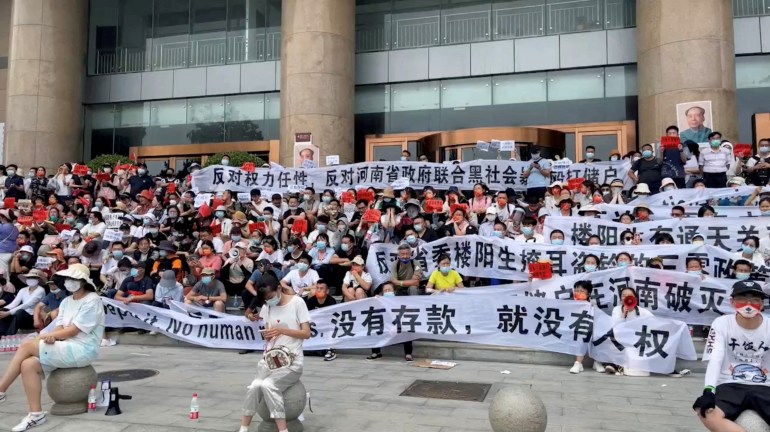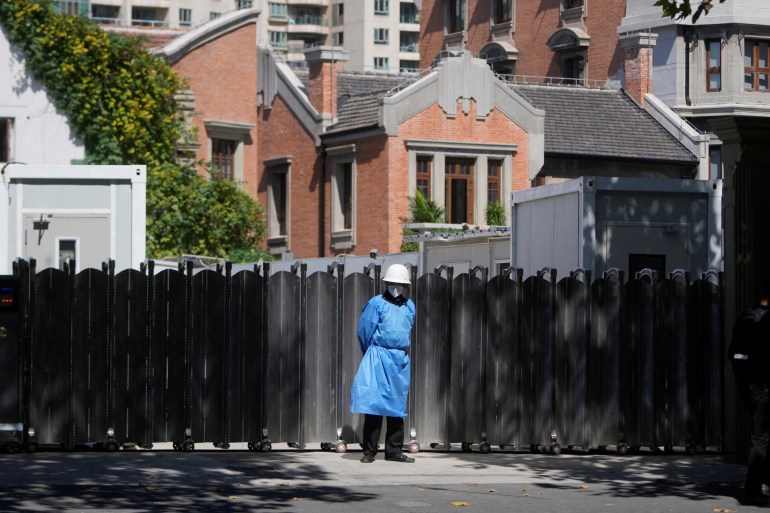A few months ago, a box was left outside the door of 34-year-old Yu Ting Xu’s* apartment in Beijing. Inside, there was an electronic monitoring wristband and a demand that she wear the wristband at all times as part of the fight against COVID-19 in her residential area.
While telling her story over a video call, Yu shuffles about in the background. When she returns to her screen, she is holding up the wristband, which looks like a smartwatch but has a plain white plastic surface instead of a display.
“I have never put it on,” she said.
“I have accepted lockdowns, forced COVID-19 tests and health codes, but this thing feels like surveillance just for the sake of surveillance.”
The wristband was the last straw for Yu who is among an increasing number of citizens concerned about the motivation for the Chinese authorities’ expansive use of COVID-19-related technology.
“I am afraid that the COVID-19 strategy is starting to be about controlling Chinese people instead of fighting COVID-19,” she told Al Jazeera.

Just a few days before Yu received the wristband, thousands of residents in central China had used social media to organise a protest outside a bank in Zhengzhou.
Many had been unable to access their bank deposits at the city’s Yu Zhou Xin Min Sheng Village Bank since April with the bank claiming that the problem was due to “system upgrades”.
Fed up with months of excuses, the depositors planned to protest in front of the bank’s headquarters. But the day before, thousands of depositors suddenly found their smartphones buzzing and the health codes on their compulsory COVID-19 apps turning from green to red.
Colour changes usually happen when the holder has visited a COVID-19-infected area or been designated a close contact with someone with the virus, and it means that the individual must quarantine immediately.
The red codes raised eyebrows.
There had not been a registered COVID-19 outbreak in the province, and the health codes of the family members who accompanied the many depositors to the protest remained green.

Beijing has said technology such as the app and wristband are crucial to its zero-COVID strategy and its commitment to stamping out the virus, but the red health codes in Zhengzhou and the electronic wristbands in Beijing have contributed to growing scepticism.
Protection causing harm
When the health code system was implemented in early 2020, rights groups, including Human Rights Watch, warned such digital tools risked breaching the human rights of any Chinese citizen with a smartphone.
In the first two years of its operation, those early warnings were largely drowned out by thundering applause at the apparent success of the zero-COVID policy. While many Western countries were stumbling from one chaotic national lockdown to the next, Chinese authorities were able to keep most of China COVID-19-free with targeted lockdowns using digital tools to prevent the infected or potentially infected from spreading the virus.
Today, however, the roles are largely reversed.
While most of the world has used vaccination as a way to move on from coronavirus restrictions, China is stuck in a loop of relentless lockdowns in an unrelenting quest to stamp out every COVID-19 outbreak. Despite the wide availability of COVID-19 vaccines and the associated decrease in death rates, Beijing’s zero-COVID policy remains firmly in place with no end in sight.
The Chinese government defends the policy as a well-meaning strategy to protect people.
But prolonged lockdowns in cities such as Shanghai have brought with them reports of food shortages, family separations and even the killing of the pets of patients sent to quarantine. In the middle of September, there was outrage when a bus transporting people to a COVID-19 quarantine centre crashed, killing 27 passengers.

The accident fed directly into the ongoing discussion in Chinese society about the accumulating costs of the government’s coronavirus policy.
“It is the government’s zero-COVID strategy that is killing us, not COVID-19,” one Weibo user declared after the accident.
His post was quickly removed by censors.
Censors were initially overwhelmed, however, by the popular uproar that swept through Chinese social media sites following the handling of the bank demonstration in Zhengzhou. What human rights organisations had warned about in 2020 had happened: digital tools supposedly implemented to secure the health of Chinese citizens had instead been used to rob those very citizens of their rights.
More intrusion, less support
Han Wu*, 37, from the southern city of Guangzhou, was among the many Chinese users on Weibo that expressed outrage following the incident in Zhengzhou. Like Yu in Beijing, he also believes that the authorities have gone too far in their pursuit of zero COVID.
Han was forced to leave his home and move into one of the government’s quarantine centres for 14 days after testing positive for COVID-19 at the end of June.
“When I returned to my apartment, I could see that the door had been forced open and my things were scattered all over the place,” he told Al Jazeera, before turning on the camera on his phone to show marks and cuts on the outside of his door as evidence of the forced entry.
Han later learned from the local authorities that they had entered his apartment to disinfect the rooms and to make sure no one else was living there. These were necessary precautions, he was told.
“I back the containment of COVID-19 infections, but I don’t back government break-ins and privacy violations,” he said.
Lin Pu is a scholar of digital authoritarianism and Chinese influence at Tulane University in the United States.
He explains that it used to be so-called terrorists, separatists, criminals and political activists who felt the Chinese authorities’ capacity for oppression, but the zero-COVID policy had exposed the usually more apolitical middle class to the strong arm of the government.
He says the discontent could prompt further abuse of the system.
“It is quite possible that the digital tools initially used for COVID control will be increasingly used for social control if dissatisfaction continues to rise,” Lin says.
“In turn, this can create a feedback loop where dissatisfaction with the COVID strategy tempts the authorities to use the digital tools to ensure social control which creates more dissatisfaction.”
‘No revolutionary’
Upset over the COVID policies comes at a time when the need for stability is paramount for China’s ruling party.
The 20th Congress of the Chinese Communist Party (CCP) is set to start on October 16 and President Xi Jinping is expected to secure an unprecedented third term, making him the party’s longest-serving leader since Mao Zedong.
The congresses are among the most important political events in China, and are held only once every five years.
“China is facing a series of compounding challenges at a time when the CCP and Xi Jinping needs China to appear prosperous and harmonious,” said Christina Chen, who specialises in Chinese politics at the Taiwanese think-tank INDSR.
The zero-COVID strategy is also damaging the economy, with growth at its slowest in decades, youth unemployment at a record 20 percent and a distorted housing market where thousands of people are refusing to pay mortgages on incomplete homes, while a decades-long building frenzy has left upwards of 50 million homes unoccupied.
“China needs to look stable, and the political projects associated with his presidency, like the zero-COVID strategy, must appear like indisputable successes in order to legitimise him serving a third term,” Chen adds.

Going into the congress, COVID cases are rising and new variants have been discovered. While no deaths have been reported since April, the government continues to stress its commitment to zero COVID no matter the resentment among the general public from the harsh restrictions and regular testing.
Back in Beijing, Yu admits the policy has made her more sceptical of the authorities.
“I am no revolutionary,” she said as she closed her fingers around the electronic monitoring wristband in her palm.
“I just don’t want to be monitored and exploited.”
When asked what she would do if she were forced to wear the wristband, she stands up and pushes her chair away.
“I will show you.”
She takes a few quick steps towards an open window at the back of the room and tosses the wristband out into the night.
* The names of Yu Ting Xu and Han Wu have been changed to protect their identities.
Stay connected with us on social media platform for instant update click here to join our Twitter, & Facebook
We are now on Telegram. Click here to join our channel (@TechiUpdate) and stay updated with the latest Technology headlines.
For all the latest World News Click Here
